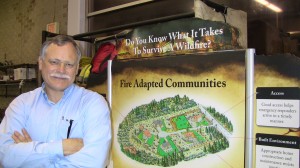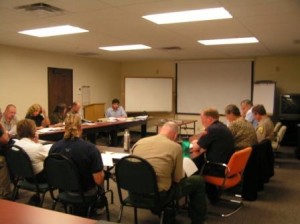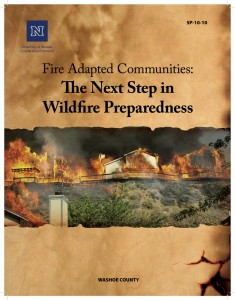Washoe County Fire Adapted Communities Project – Fire Adapted Communities and Community Wildfire Protection Planning
February 1st, 2012
By: Ed Smith
Natural Resource Specialist University of Nevada Cooperative Extension
For many, evidence of the Caughlin Fire is a daily reminder of the threat wildfire poses to the Reno area. Strong winds, burning embers, an abundance of dried leaves, needles and grass, inadequate defensible space and houses built from easily ignited materials played a huge role in the loss of homes during the Caughlin Fire. A question that hopefully springs from that event is what will we, as a community, do differently between now and the next wildfire?
Last year, University of Nevada Cooperative Extension, representatives from local, state and federal firefighting agencies, and the Nevada Fire Safe Council introduced the concept of Fire Adapted Communities (FACs) to several Washoe County neighborhoods at risk from wildfire. FACs are communities located in wildfire-prone areas that can survive wildfire with little or no assistance from firefighters.

Representatives from Washoe County's federal, state and local firefighting agencies, the Nevada Fire Safe Council, homeowners, county government and University of Nevada Cooperative Extension meet to discuss the elements of a new Washoe County CWPP planning guide and template.
The FAC concept represents a departure from traditional thinking about our response to
the wildfire threat. Historically, we responded by protecting communities with firefighters and equipment
when wildfire occurred. In FACs, the emphasis changes from “protection of communities” to “preparation of communities” and shifts the responsibility for dealing with the wildfire threat from being solely the fire department’s task to the community as a whole.
Shifting our thinking now is critical given some disturbing projections from the nation’s wildfire experts:
- Fire seasons will become longer, more intense, and speelautomaten wildfires will be more difficult to control.
- The number of people living in or adjacent to high fire-hazard areas will increase.
- Our firefighting resources will not keep pace with the increased wildfire threat.
They concluded that the economic, environmental and societal costs of wildfire will dramatically increase in the future and identified FACs as a key component to minimizing the anticipated impacts from wildfire.
In 2012, Living With Fire will focus on the importance of Community Wildfire Protection Plans (CWPPs) as a vehicle for incorporating the FAC recommendations into community design and maintenance, and taking communities to the next step in wildfire preparedness.

CWPP planning assists communities in establishing priorities for protecting life, property and infrastructure. The plans can take a variety of forms, but at a minimum must:
- Be collaboratively developed
- Identify and prioritize areas and methods for hazardous fuel-reduction treatments
- Recommend measures to reduce the ignitability of structures throughout the community
The Living With Fire program and its partners are currently preparing a Washoe County Community-Level CWPP guide to assist communities into and through the CWPP process.
It’s important for residents to begin asking questions like “what is the wildfire threat to my community?” and “how do I prepare for wildfire?” By reading the educational materials at www.LivingWithFire.info, taking the steps to become a FAC and by starting the CWPP process, Reno residents can prepare themselves for the next wildfire and greatly decrease its impact on their home and family.
Please check back regularly as we develop this program.
